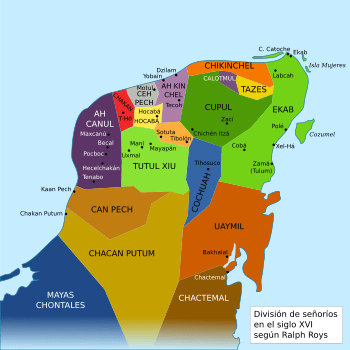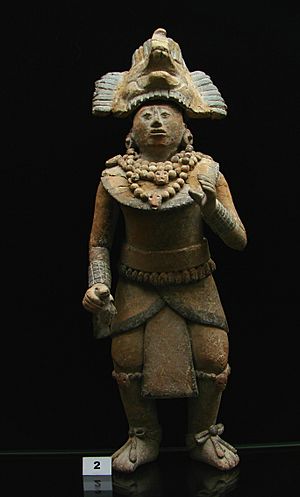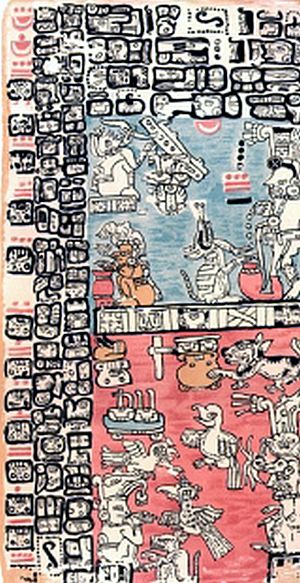Chakán Putum facts for kids
Quick facts for kids
Kuchkabal Chakan Putum
|
|||||||||
|---|---|---|---|---|---|---|---|---|---|
| 1441–1547 | |||||||||

Kuchkabals of Yucatan after 1461.
|
|||||||||
| Capital | Chakan Putum | ||||||||
| Common languages | Official language: Yucatec |
||||||||
| Religion | Maya religion | ||||||||
| Government | Monarchy | ||||||||
| Halach Uinik | |||||||||
| Historical era | post classic period / Early Modern | ||||||||
|
• Established
|
1441 | ||||||||
|
• Disestablished
|
1529 | ||||||||
|
|||||||||
Chakán Putum was an important Maya kingdom, also called a chiefdom, located in the southwestern part of the Yucatán Peninsula. This was before the Spanish explorers arrived in the 1500s. The kingdom was named after its main city, Chakan Putum. This city was quite large, with about 8,000 homes, and it was a very busy port.
Contents
How Chakán Putum Was Organized
After a big war between two Maya groups, the Tutul Xiu and the Cocom, the Yucatán Peninsula split into about 16 smaller kingdoms called kuchkabalob. In the area that is now the state of Campeche, there were three of these kingdoms: Ah Canul, Can Pech, and Chakán Putum. These kingdoms often had conflicts with each other.
Each kuchkabal usually had a capital city. This is where the main ruler and the most important priest lived. The ruler was known as the Halach Uinik. Each kingdom was also divided into smaller areas, like towns, called "Batalib". These towns were led by officials called "Batab", who were often related to the Halach Uinik. Each Batab was also the military leader for their town.
When it came to religion, the Ah Kin May was the most important priest after the Halach Uinik. There were also regular priests called Ah Kin, which means "coming from the Sun". Another type of priest was the "Ah Nacom", who performed sacrifices.
Where Chakán Putum Was Located
The people of Chakán Putum lived near the Champotón River, and the area was named after them. To the west of Chakán Putum was the Gulf of Mexico. To the southwest was Tabasco, which was home to the Chontales Maya people. To the north was the Can Pech territory. To the east, though the exact border wasn't always clear, were cities like Ulumal, Haltunchén, and Sihocha.
The people of Chakán Putum and Chactemal belonged to the Putún ethnic group. This meant that people often moved between their lands. The Spanish explorers sometimes called both Can Pech and Chakán Putum by the name "Chochistán". The Chontales Maya city of Tixchel was only about 70 kilometers (43 miles) southwest of Chakán Putum. Chakán Putum was a very important stop for trade. Goods traveled through it from cities in Tabasco like Cupilco, Potonchán, and Xicalango, to other parts of the Yucatán Peninsula and the Caribbean Sea.
Chakán Putum's Economy
Spanish explorers wrote about Chakán Putum as a city with 8,000 houses. They also mentioned a large fishing fleet of over 2,000 canoes. These canoes went out to sea every day. When they returned, they would visit a special reef temple to pray and thank their gods. The Champotón River was easy to travel on by boat. Maya merchants used it to reach areas further inland. After the Spanish took control, the local people had to pay taxes in fish. Other important settlements in the Chakán Putum area during this time included Si Ho Beach, Haltunchen, Sihochac, Kehte, and Teop.
First Meetings with Europeans
The Spanish fought battles against the Maya of Chakan Putum in 1517, 1518, and 1519. Chakan Putum had a strong fighting force with 2,000 war canoes. After the Spanish made friends with the nearby Can Pech people and conquered Tabasco, they invaded Chakán Putum a fourth time between 1527 and 1528.
On March 25, 2021, the President of Mexico, Andrés Manuel López Obrador, along with the President of Bolivia, Luis Alberto Arce Catacora, honored the people of Chakán Putum. They marked 504 years of the local people's resistance against the arrival of the Europeans.
See also
 In Spanish: Chakán Putum para niños
In Spanish: Chakán Putum para niños



